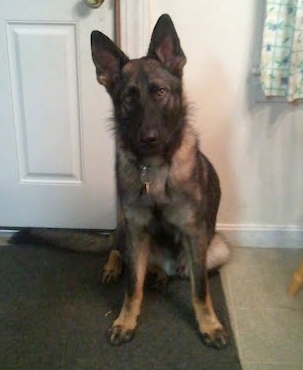I get this question from time to time when I’m out and about with Freya – our adopted German Shepherd. I wrote about her arrival from a kill-shelter in Alabama at my personal blog last year, but thought it might be time for a follow-up, now that she’s been with us for just over a year.

Freya is indeed a purebred German Shepherd. I’m a fanatic of the breed and owned a GSD (German Shepherd Dog) for 11 years until she passed away from cancer. That was about 2 years before we adopted Freya. I also worked in the pet-care industry for many years prior to going back to school for my Master’s, which gave me a thorough understanding of many dog breed standards. Based on both her physical qualities and her personality traits, there’s no doubt in my mind that she’s all GSD. I will note that despite being a breed loyalist, I’m also a proponent of adopting dogs so both my previous dog Pandora, and Freya were adopted.
So what’s the deal with her ears?
Freya was picked up off the street down in Alabama with no collar or information, so there’s no way to know exactly what happened to her before she arrived at the shelter. But based on her permanently folded ears (one big reason I get asked about whether she’s a purebred), along with her inability to run (her first couple of attempts were dreadfully sad – she would try a gallop only to have her back-end go out from under her, or have her front feet trip her up. She had no coordination at any pace faster than a trot), and her absolute need to be in a crate at times, brought me to the conclusion that she lived most, if not all of her first 7 months of life in a cage. Too sad.
German Shepherd puppies have folded ears when they’re little (they’re also very dark – many are almost all black; their adult coat pattern doesn’t fully come out until they’re about 1 & 1/2 – 2 years old) . Some individuals have such big ears that they need a little help getting them to stand up. My first dog fell into this category. There are several methods to make dog’s ears stand upright (some are harsher than others), and I tried the softest technique first – rubbing the ear cartilage on a regular basis to encourage blood circulation. Eventually – whether due to my help or not – Pandora’s ears finally stood upright. At first I had assumed that Freya just didn’t have anyone paying attention and her ears had needed help standing up on their own and no one did anything about it. While that definitely could be the case, I did observe that when she’s standing in her crate at home (where she has the freedom to come and go on her own) she’s just tall enough that her ears can’t stand up. Perhaps she was kept in a small enough crate that her poor ears just didn’t have the room they needed.
Folded ears or no, Freya is just the sweetest, most loving dog I have ever known. I’ve heard many people say that rescue dogs have a definite sense of gratitude about them. I know Freya definitely does. All she wants is to be loved, and she’ll flop down on her back at your feet and “talk” to you (something between a whine and a growl) until you pay some attention. I usually can’t resist and just flop down next to her to rub her belly and cuddle. I can’t imagine my life without her and don’t know who’s luckier – her or us.
